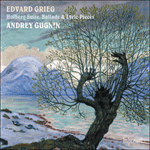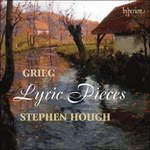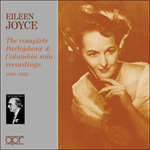
Welcome to Hyperion Records, a British classical label devoted to presenting high-quality recordings of music of all styles and from all periods from the twelfth century to the twenty-first.
Hyperion offers both CDs, and downloads in a number of formats. The site is also available in several languages.
Please use the dropdown buttons to set your preferred options, or use the checkbox to accept the defaults.

| Andrey Gugnin (piano)» More |
Grieg’s Lyric Pieces were published in ten volumes between 1867 and 1901. Andrey Gugnin has chosen to play the complete Opp 43 and 62 sets, published respectively in 1887 and 1895. In a letter to his publisher, Grieg described Book 3 (Op 43) as ‘Frühlingslieder’ (‘Spring songs’) and indeed the set opens with a fluttering ‘Butterfly’—a wonderfully Mendelssohnian evocation and one of Grieg’s best-loved works. The third volume ends with ‘To spring’, among the greatest of all the Lyric Pieces, much of it written on three staves and rising to an impassioned climax before subsiding to its whispered ending. Grieg himself recorded both these works in 1903. While Book 6 of his Lyric Pieces is generally shadowy and introspective, Book 7 (Op 62) reverts to the cheerful mood of Book 3, beginning with the coquettish waltz of ‘Sylph’. The final piece, ‘Homeward’, with its exuberant opening and serene second subject, one might describe as quintessential Grieg.
from notes by Jeremy Nicholas © 2024
Les Pièces lyriques de Grieg furent publiées en dix volumes entre 1867 et 1901. Andrey Gugnin a choisi de jouer l’intégralité des op.43 et 62, publiés respectivement en 1887 et 1895. Dans une lettre à son éditeur, Grieg décrivit le Cahier 3 (op.43) comme des «Frühlingslieder» («Mélodies de printemps») et le recueil débute avec un «Papillon» voletant—une évocation merveilleusement mendelssohnienne et l’une des œuvres préférées de Grieg. Le troisième volume se termine par «Au printemps», la plus importante de toutes les Pièces lyriques, en grande partie écrite sur trois portées et qui s’élève jusqu’à un sommet passionné avant de disparaître dans une conclusion murmurée. Grieg lui-même enregistra ces deux œuvres en 1903. Si le Cahier 6 de ses Pièces lyriques est dans l’ensemble sombre et introspectif, le Cahier 7 (op.62) revient à l’atmosphère joyeuse du Cahier 3, commençant par la valse aguichante «Sylphe». Le dernière pièce («Vers la patrie»), avec son début exubérant et son second sujet serein, pourrait être considérée comme la quintessence de Grieg.
extrait des notes rédigées par Jeremy Nicholas © 2024
Français: Marie-Stella Pâris
Griegs Lyrische Stücke wurden zwischen 1867 und 1901 in zehn Bänden veröffentlicht. Andrey Gugnin hat sich entschieden, die Zyklen op. 43 und op. 62 vollständig einzuspielen, die 1887 bzw. 1895 veröffentlicht wurden. In einem Brief an seinen Verleger bezeichnete Grieg den dritten Band (op. 43) als „Frühlingslieder“, und in der Tat beginnt diese Werkreihe mit einem flatternden „Schmetterling“—eine wunderbare Mendelssohn’sche Darstellung sowie eines von Griegs beliebtesten Werken. Der dritte Band endet mit einem der brillantesten der Lyrischen Stücke, „An den Frühling“, das größtenteils auf drei Systemen notiert ist und sich zu einem leidenschaftlichen Höhepunkt steigert, bevor es mit einem geflüsterten Ende abklingt. Grieg nahm diese beiden Werke selbst im Jahr 1903 auf. Während der sechste Band seiner Lyrischen Stücke zumeist geheimnisvoll und beschaulich gehalten ist, kehrt die Atmosphäre im siebten Band (op. 62) zu der heiteren Stimmung des dritten zurück und beginnt mit dem koketten Walzer „Sylphide“. Das letzte Stück, „Heimwärts“, mit seinem überschwänglichen Beginn und dem heiteren zweiten Thema ist in hohem Maße charakteristisch für Grieg.
aus dem Begleittext von Jeremy Nicholas © 2024
Deutsch: Viola Scheffel
 Grieg: Holberg Suite, Ballade & Lyric Pieces Grieg: Holberg Suite, Ballade & Lyric PiecesIf Grieg’s ‘Holberg Suite’ is more familiar in its arrangement for string orchestra, Andrey Gugnin’s lyrical account of the original solo piano version shows us just what we’ve been missing.» More |
 Grieg: Lyric Pieces Grieg: Lyric PiecesTwenty-seven of Grieg’s most perfect miniatures selected and lovingly recorded by that most mercurial of pianists Stephen Hough: the famous ‘Wedding Day at Troldhaugen’, ‘March of the Trolls’, and many others rather less well known.» More |
 Eileen Joyce - The complete Parlophone & Columbia solo recordings Eileen Joyce - The complete Parlophone & Columbia solo recordings‘Listening to Joyce is strangely addictive. One cannot wait, as it were, to read the next chapter. She shares with Kreisler and Tauber the same unteac ... ‘The quality that comes across in these performances is the sheer joy of playing. Joyce possessed a formidable technique and an interpretative mind th ...» More |

